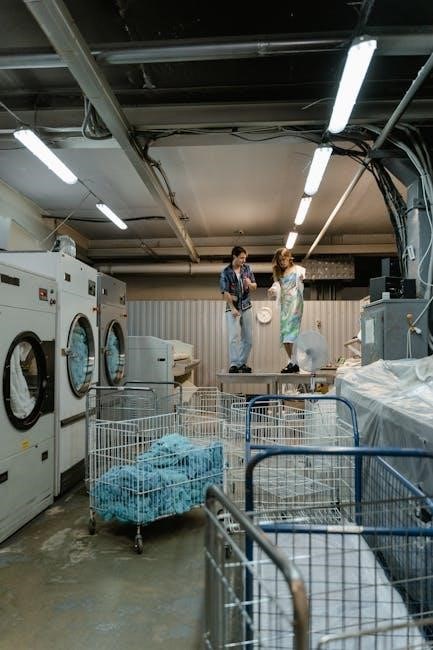Welcome to the GE Dryer Manual‚ your comprehensive guide to installing‚ operating‚ and maintaining your appliance. This manual provides essential information for safe and efficient use‚ ensuring optimal performance and longevity of your dryer. Read carefully to understand features‚ safety precautions‚ and maintenance tips.

1.1 Understanding the Importance of the Manual
This manual is a crucial resource for ensuring the safe‚ efficient‚ and proper operation of your GE dryer. It provides detailed instructions‚ safety guidelines‚ and maintenance tips to help you make the most of your appliance. By following the manual‚ you can avoid potential hazards‚ prolong the lifespan of your dryer‚ and ensure optimal performance. The manual covers essential topics such as installation requirements‚ venting guidelines‚ and troubleshooting‚ making it an indispensable tool for both new and experienced users.
The instructions outline specific safety precautions to prevent accidents‚ such as fires or electrical issues‚ and emphasize the importance of proper venting and electrical connections. Additionally‚ the manual highlights features and functionalities unique to GE dryers‚ helping you understand how to use them effectively. Regular maintenance tasks‚ such as cleaning the lint filter and inspecting the venting system‚ are also explained in detail to ensure your dryer operates efficiently and safely over time. This guide is designed to be a long-term reference‚ so keep it handy for future use and share it with anyone who may operate the appliance.
1.2 Overview of the Guide
This guide provides a comprehensive overview of your GE dryer‚ ensuring you understand its features‚ operation‚ and maintenance requirements. It is structured to help you navigate through the appliance’s capabilities safely and efficiently. The manual is divided into key sections‚ starting with an introduction to the dryer’s importance and this guide’s purpose.
The guide then details installation requirements‚ including location selection‚ step-by-step installation processes‚ and venting and electrical connections. Safety guidelines are emphasized‚ covering general precautions‚ specific warnings‚ and tips for preventing fires and hazards. Additionally‚ the manual highlights the dryer’s features and functionalities‚ such as standard and optional advanced settings.
Operating instructions are provided‚ guiding you through preparing clothes‚ selecting cycles‚ starting the drying process‚ and monitoring the dryer’s operation. Maintenance and upkeep are also covered‚ with advice on cleaning the lint filter and maintaining the venting system. This guide is designed to be a complete resource‚ ensuring you get the most out of your GE dryer while prioritizing safety and efficiency.

Installation Requirements
Proper installation ensures safe and efficient dryer operation. Choose a well-ventilated‚ dry location away from freezing temperatures. Ensure correct electrical connections and venting to prevent damage and hazards. Follow the manual’s specific guidelines for optimal performance.
2.1 Choosing the Right Location
Choosing the right location for your GE dryer is crucial for safe and efficient operation. Ensure the area is well-ventilated‚ dry‚ and free from dust to prevent fire hazards. Avoid installing the dryer in rooms prone to frost‚ as residual water in the unit could freeze and cause damage. The location should be accessible for proper venting and electrical connections. Keep the dryer away from flammable materials and ensure it is placed on a level surface. Do not install the dryer directly above or below electrical outlets to avoid potential risks. The room should maintain a consistent warm temperature to optimize drying performance. Always follow the guidelines outlined in the user manual for specific installation requirements. Proper placement ensures the dryer operates safely and efficiently‚ extending its lifespan and preventing potential hazards.
2.2 Step-by-Step Installation Process
Follow these steps to ensure your GE dryer is installed correctly. Begin by carefully unpacking the dryer from its packaging and inspecting for any damage. Place the dryer in the previously chosen location‚ ensuring it is level and stable. Use a spirit level to verify even placement and adjust the legs if necessary. Next‚ connect the venting system according to the manufacturer’s instructions‚ ensuring all joints are secure and properly sealed. Install a 4-inch vent duct from the dryer to the exterior of your home to ensure proper airflow. For electrical connections‚ plug the dryer into a dedicated 240-volt outlet‚ as specified in the manual. Do not use extension cords or adapters. Once all connections are made‚ test the dryer by running a short cycle to ensure it operates smoothly. Refer to the manual for specific instructions on securing the dryer and ensuring all safety features are activated. Proper installation is essential for safe and efficient operation. Always consult a professional if you are unsure about any step.
2.3 Venting and Electrical Connections
Proper venting and electrical connections are crucial for the safe and efficient operation of your GE dryer. Begin by installing a 4-inch vent duct from the dryer to the exterior of your home‚ ensuring it is free from kinks and obstructions. Avoid using flex ducts‚ as they can restrict airflow and increase fire risk. Secure all connections with clamps or screws to prevent leaks. For electrical connections‚ ensure the dryer is plugged into a dedicated 240-volt outlet. Verify that the circuit is rated for 30 amps and uses a 4-wire connection‚ including a ground wire for safety. Never use extension cords or adapters‚ as they can overheat and pose a fire hazard. If you are unsure about any aspect of the electrical setup‚ consult a licensed electrician. Proper venting and electrical connections are essential to prevent hazards and ensure optimal performance. Always follow the manufacturer’s guidelines and local building codes for a safe installation.

Safety Guidelines
Always follow safety guidelines to ensure safe operation of your GE dryer. Never operate the dryer without the lint filter‚ and keep the area around it clear of flammable materials. Ensure proper installation to avoid hazards and adhere to the manufacturer’s instructions for electrical and venting connections.
3.1 General Safety Precautions
To ensure safe operation of your GE dryer‚ follow these general safety precautions. Always read the manual thoroughly before use. Never operate the dryer without the lint filter‚ as this can cause fires. Keep the area around the dryer free from flammable materials‚ such as curtains or cleaning supplies. Avoid installing the dryer in frost-prone areas‚ as residual water may freeze and damage the appliance. Ensure the dryer is placed in a well-ventilated‚ dry‚ and warm room to prevent moisture buildup. Children should be supervised when near the dryer‚ and pets should be kept away. Do not overload the dryer‚ as this can lead to mechanical issues. Always unplug the dryer during cleaning or maintenance. Regularly inspect the power cord for damage and ensure the dryer is properly grounded to prevent electrical hazards. Follow all manufacturer recommendations for installation and operation to minimize risks and ensure optimal performance. By adhering to these guidelines‚ you can enjoy safe and efficient use of your GE dryer.
3.2 Specific Safety Warnings
Adhere to these specific safety warnings to ensure safe operation of your GE dryer. Never install the dryer in areas prone to frost‚ as residual water may freeze and cause damage. Avoid installing the dryer directly under an electrical outlet to prevent fire hazards. Always ensure the dryer is properly vented to the outdoors‚ as improper venting can lead to carbon monoxide buildup or fires. Do not use fabric softener sheets or dryer sheets that can ignite or cause sparks. Never dry items like shoes‚ cushions‚ or mattresses‚ as they may not dry properly and could pose a fire risk. Keep the dryer vent clean and free of lint to avoid obstruction‚ which can cause overheating. Never leave the dryer unattended during operation‚ especially when drying items like towels or bulky fabrics. Do not use the dryer near open flames‚ sparks‚ or hot surfaces‚ as this can ignite lint or debris. Always follow the manufacturer’s guidelines for drying specific fabrics and materials to avoid damage or hazards. By adhering to these warnings‚ you can significantly reduce the risk of accidents and ensure safe operation of your GE dryer.

3.3 Preventing Fires and Hazards
Preventing fires and hazards is crucial for safe dryer operation. Always clean the lint filter after each use to avoid blockages that can cause overheating. Ensure the venting system is clear of obstructions‚ as improper ventilation can lead to carbon monoxide buildup or fires. Avoid drying items like towels‚ bulky fabrics‚ or those with metal parts‚ as they may create sparks or retain excessive heat. Never leave the dryer unattended while it is running‚ as unexpected issues may arise. Keep the area around the dryer free from clutter‚ flammable materials‚ and liquids. Do not dry items soaked in flammable liquids or chemicals‚ as they can ignite during the drying cycle. Regularly inspect the dryer’s venting system for damage or blockages and ensure it is securely connected to the outdoor vent. Never use the dryer if it is malfunctioning or making unusual noises‚ as this could indicate a potential fire hazard. By following these precautions‚ you can significantly reduce the risk of fires and ensure a safer environment for using your GE dryer.

Features and Functionalities
GE dryers offer a range of features to enhance drying efficiency and convenience. Standard features include multiple drying cycles‚ moisture sensors‚ and eco-mode for energy savings. Optional advanced features like smart connectivity‚ steam drying‚ and sanitize cycles provide additional flexibility for customized fabric care.
4.1 Standard Features of GE Dryers
GE dryers are equipped with a variety of standard features designed to enhance performance and user convenience. These include multiple drying cycles tailored for different fabric types‚ such as delicate‚ normal‚ and heavy-duty settings. Many models come with moisture sensors that automatically detect when clothes are dry‚ preventing over-drying and saving energy. Additionally‚ GE dryers often feature an eco-mode that reduces energy consumption while maintaining effective drying results. Some models also include a quiet operation feature‚ making them ideal for households that value a peaceful environment. The appliances are designed with a user-friendly interface‚ including digital displays and easy-to-use controls. Standard safety features‚ such as automatic shut-off and child locks‚ are also included to ensure safe operation. These features collectively provide a balance of efficiency‚ convenience‚ and reliability‚ making GE dryers a practical choice for everyday use.
4.2 Optional Advanced Features
GE dryers also offer a range of optional advanced features that enhance functionality and user experience. One notable feature is smart connectivity‚ allowing users to control and monitor their dryer remotely through a smartphone app. This feature enables remote start‚ status updates‚ and custom cycle selections. Additionally‚ some models include steam drying technology‚ which helps reduce wrinkles and odors in clothes‚ making ironing easier and extending fabric life. Advanced moisture-sensing technology is another optional feature‚ which automatically adjusts drying time based on load size and fabric type‚ ensuring clothes are dried evenly without over-drying. Energy-saving modes are also available on select models‚ optimizing energy consumption while maintaining performance. Some high-end models may include a sanitize cycle‚ which uses high heat to eliminate bacteria and allergens‚ ideal for families with sensitive skin. Optional quiet operation modes further enhance convenience‚ especially for households that prioritize noise reduction. These advanced features provide users with greater flexibility and customization options‚ catering to diverse laundry needs and preferences.

Operating the Dryer
Operating your GE dryer involves sorting clothes‚ selecting the appropriate cycle‚ and starting the machine. Ensure the lint filter is clean and the venting system is clear. Use fabric softener sheets if desired. Monitor cycles and adjust settings as needed for optimal drying performance.

5.1 Preparing Clothes for Drying
Before operating your GE dryer‚ proper preparation of clothes is essential to ensure efficient drying and prevent damage. Start by sorting clothes based on fabric type‚ thickness‚ and color to avoid bleeding or damage. Remove loose items from pockets‚ such as coins or keys‚ to prevent noise and potential damage during the cycle. Unbutton shirts and zippers to allow even drying. Avoid overloading the dryer‚ as this can reduce efficiency and cause wrinkling. Place delicate or fragile items in mesh laundry bags for protection. Ensure all clothes are free of excess moisture by spinning them in the washer. For best results‚ add a fabric softener sheet to reduce static and freshen clothes. Never mix damp and dry clothes‚ as this can prolong drying time. Finally‚ check the care labels on garments to ensure they are suitable for machine drying. Proper preparation ensures optimal performance and extends the life of your clothes and dryer.
5.2 Selecting the Right Cycle
Selecting the appropriate drying cycle is crucial for optimal performance and fabric care. GE dryers offer a variety of cycles tailored to different fabric types and drying needs. Start by checking the care label on your garments to determine the recommended heat setting and cycle type. Common cycles include Delicate‚ Normal‚ Heavy Duty‚ and Bulky Items. The Delicate cycle uses low heat and gentle tumbling‚ ideal for sensitive fabrics like lingerie or wool. The Normal cycle is suitable for everyday clothes‚ while Heavy Duty is designed for thick or heavily soiled items like towels and jeans. For large or bulky items‚ such as comforters‚ use the Bulky Items cycle‚ which ensures even drying. Many GE dryers also feature advanced options like Sensor Dry‚ which automatically adjusts drying time based on moisture levels. Always match the cycle to the fabric type and load size for efficient drying and to prevent damage. Avoid overloading the dryer‚ as this can reduce airflow and extend drying time. Proper cycle selection ensures your clothes are dried thoroughly while preserving their quality and longevity.
5.3 Starting the Drying Process
Once you’ve prepared your clothes and selected the appropriate cycle‚ you’re ready to start the drying process. Ensure the lint filter is clean to maintain proper airflow and efficiency. Open the dryer door and load the clothes loosely‚ avoiding overcrowding‚ which can hinder drying performance. Close the door firmly to ensure a proper seal. Next‚ select the desired cycle and options using the control panel. If your GE dryer has a moisture sensor‚ it will automatically adjust the drying time based on the load’s moisture level. Add a dryer sheet if desired for fabric softening and anti-static reduction. Press the Start button to begin the cycle. The dryer will activate and display the remaining time. During operation‚ ensure the venting system is functioning properly to prevent overheating and maintain efficiency. Do not leave the dryer unattended‚ especially when drying items like towels or bulky fabrics‚ which may require periodic checking. Always follow the manufacturer’s guidelines and safety precautions to ensure safe and effective operation. Proper usage will extend the life of your dryer and ensure optimal performance.
5.4 Monitoring the Dryer’s Operation
Once the drying cycle has started‚ it’s important to monitor the dryer’s operation to ensure safe and efficient performance. Check the venting system regularly to ensure it’s clear of blockages‚ as obstructed vents can lead to reduced efficiency or potential hazards. The dryer’s control panel will display the remaining cycle time‚ allowing you to track progress. If your GE dryer is equipped with a moisture sensor‚ it will automatically adjust the drying time based on the moisture levels of the clothes. For optimal results‚ avoid overloading the dryer‚ as this can impede airflow and extend drying times. Do not leave the dryer unattended during operation‚ especially when drying items like towels or bulky fabrics‚ which may require periodic checking. Ensure the lint filter is clean before and after each use to maintain proper airflow and prevent fire hazards. Additionally‚ keep the area around the dryer clear of flammable materials. Regular monitoring ensures the dryer operates safely and efficiently‚ extending its lifespan and maintaining peak performance. Always refer to your specific GE dryer model’s manual for detailed guidance on monitoring and troubleshooting during operation.

Maintenance and Upkeep
Regular maintenance ensures your GE dryer operates efficiently and safely. Clean the lint filter after each use to prevent fires and improve airflow. Check the venting system for blockages and ensure it’s securely connected to maintain proper function and prevent hazards.
6.1 Cleaning the Lint Filter
Cleaning the lint filter is a crucial maintenance task for your GE dryer. It should be done after every use to ensure efficient drying and prevent potential fires. To clean the filter‚ turn off the dryer and unplug it for safety. Locate the lint filter‚ typically found in the door opening or top of the dryer‚ and pull it out. Remove any visible lint by hand or use a soft-bristled brush to sweep away debris. For thorough cleaning‚ rinse the filter with warm water and let it dry completely before reinstalling it. Never operate the dryer without the lint filter‚ as this can cause overheating and damage. Regular cleaning improves airflow‚ reduces energy consumption‚ and extends the lifespan of your dryer. Additionally‚ check the filter for tears or damage and replace it if necessary. Proper maintenance ensures safe and efficient operation of your GE dryer.

6.2 Maintaining the Venting System
Maintaining the venting system of your GE dryer is essential for ensuring efficient operation and safety. Regularly inspect the venting system to ensure it is free from blockages‚ such as lint‚ debris‚ or pests. A clogged venting system can lead to reduced drying performance‚ increased energy consumption‚ and potential fire hazards. Start by disconnecting the dryer from the power source before performing any maintenance. Remove the venting hose from the dryer and inspect it for kinks‚ dents‚ or damage. Clean out any accumulated lint or debris using a vacuum cleaner or a specialized vent cleaning brush. Ensure the venting system is properly secured to the dryer and the exterior vent outlet. Check the outdoor vent cover for obstructions and make sure it opens and closes freely to allow moisture to escape. Clean the outdoor venting system at least once a year or more frequently if you notice reduced airflow. Proper maintenance of the venting system ensures your GE dryer operates safely and efficiently‚ preventing potential hazards and extending its lifespan.